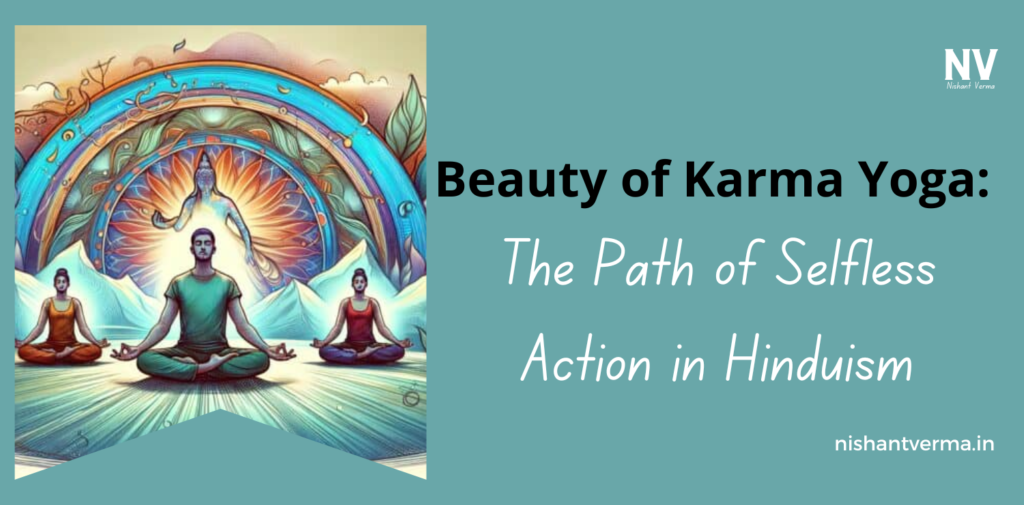Karma Yoga, often known as the “path of selfless action,” is a central concept in Hindu philosophy that teaches us how to live a fulfilling and meaningful life through acts of service and devotion. Unlike other spiritual paths that focus on meditation or devotion, Karma Yoga emphasizes action—how we engage with the world and the motivations behind what we do. In this article, we will explore the beauty of Karma Yoga, its principles, and how it can help us live a more purposeful and peaceful life.
What is Karma Yoga?
The term Karma Yoga is derived from two words: “Karma,” meaning action, and “Yoga,” which means union or path. So, Karma Yoga means “the path of action.” In Hinduism, Karma refers to actions or deeds, and the belief is that every action we perform has consequences, either good or bad, that impact our future. However, Karma Yoga teaches us to perform our actions without attachment to the results, focusing solely on the act itself, with a sense of selflessness and devotion.
The core principle of Karma Yoga is that one should act in the world, but without being attached to the fruits or outcomes of those actions. This idea is beautifully encapsulated in the Bhagavad Gita, one of the most important scriptures in Hinduism. In Chapter 2, Verse 47, Lord Krishna says to Arjuna:
“You have a right to perform your prescribed duties, but you are not entitled to the fruits of your actions. Never consider yourself to be the cause of the results of your activities, nor be attached to inaction.”
This profound teaching encourages individuals to act with full dedication and sincerity but without ego, pride, or desire for personal gain.

Essence of Karma Yoga: Selflessness and Detachment
At the heart of Karma Yoga is the idea of selflessness. The primary focus is on doing good for others without expecting anything in return. This doesn’t mean that one should stop caring about the results of their actions, but rather that they should not be consumed by them.
In life, we often perform actions with a focus on personal rewards, such as fame, money, or recognition. But in Karma Yoga, we are encouraged to act out of love, compassion, and duty. The actions themselves become a way of offering service to the world, rather than a means to achieve a personal goal.
The second essential idea in Karma Yoga is detachment. This doesn’t mean that we become cold or indifferent to the world around us, but rather that we do not cling to the outcomes of our actions. Whether the results are good or bad, we remain unaffected, maintaining inner peace and equanimity. This attitude of detachment helps us avoid stress, anxiety, and disappointment, allowing us to continue our work with a calm and open heart.

How Karma Yoga Benefits Us
- Inner Peace and Contentment: The practice of Karma Yoga leads to inner peace. When we perform actions without the burden of expectations, we can enjoy the process of work itself, rather than stressing over the results. This helps to free us from feelings of anxiety and frustration, bringing greater contentment and joy in life.
- Freedom from Ego: By acting selflessly and without attachment, we reduce the dominance of our ego. Our actions no longer revolve around “I” and “me,” but instead, focus on serving others and the greater good. This shift helps to cultivate humility and compassion, allowing us to be more connected with the world around us.
- Cultivation of Compassion: When we engage in selfless service, we naturally develop a sense of empathy and compassion toward others. It helps us understand the struggles and suffering of others, motivating us to act in ways that benefit them, rather than focusing solely on our own needs.
- Spiritual Growth: Karma Yoga is not only about helping others but is also a way of cultivating spiritual growth. Through selfless action, we gradually purify our hearts and minds, bringing us closer to the divine. Karma Yoga teaches us that every action, no matter how small, can be a form of worship when done with a pure heart and a sense of devotion.
- A Balanced Life: In the busy world we live in, it is easy to become overwhelmed by our desires and ambitions. Karma Yoga teaches us to find a balance between our duties and our spiritual practice, helping us integrate our worldly responsibilities with our higher purpose. It encourages us to act responsibly, contribute to society, and live with integrity.

Examples of Karma Yoga in Daily Life
Karma Yoga does not require us to become monks or renounce the world. It can be practiced in our daily lives, and in everything we do. Here are some simple ways in which we can incorporate Karma Yoga into our routine:
- Helping Others Without Expectation: Offering a helping hand to someone in need, whether it’s a family member, a friend, or even a stranger, is an act of selfless service. When we help others, we do so to improve their lives, without expecting anything in return.
- Doing Your Job with Dedication: Whether you are a teacher, doctor, artist, or homemaker, doing your work with full dedication and sincerity is an expression of Karma Yoga. When you focus on doing your job well, not for praise or reward, but because it is your duty, you are practising selfless action.
- Taking Care of the Environment: Every small action that helps preserve nature, such as recycling, planting trees, or reducing waste, is a form of selfless service. By caring for the environment, we are not only benefiting ourselves but also ensuring that future generations can live in a healthy world.
- Listening with Compassion: Sometimes, the most valuable thing we can give to others is our attention. Listening to someone who is struggling, and offering them a compassionate ear, is a form of selfless action. It requires us to be present and focused on the other person’s needs without expecting any benefit for ourselves.
- Volunteering: Volunteering your time and resources for a cause you care about is one of the most direct ways to practice Karma Yoga. Whether it’s helping at a local food bank, teaching underprivileged children, or assisting at an animal shelter, you are engaging in selfless service that benefits both you and others.
Conclusion: The True Joy of Karma Yoga
Karma Yoga teaches us that happiness doesn’t come from accumulating wealth or achieving success, but from the selfless actions we perform for the well-being of others. By focusing on the present moment and acting with love, humility, and devotion, we can transcend the cycle of desire and attachment that often leads to suffering.
The beauty of Karma Yoga lies in its simplicity. It doesn’t ask us to renounce the world but rather to engage with it in a way that is meaningful and fulfilling. Every action, when done with the right intention, can be a form of worship, a way to serve the divine in all beings.
By incorporating this into our lives, we can cultivate a sense of purpose, balance, and peace. In doing so, we move closer to the ultimate goal of spiritual liberation, or Moksha, where the soul is freed from the cycles of birth and rebirth and united with the divine.
In the end, the path of selfless action is not just a philosophy, but a way of life—one that encourages us to give without expecting, to love without conditions, and to live in harmony with the world around us. This is the true beauty of Karma Yoga.




